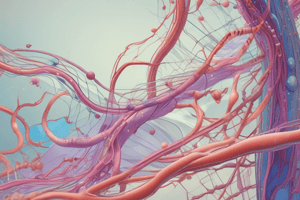Podcast
Questions and Answers
What is the primary function of lysyl oxidases in collagen synthesis?
What is the primary function of lysyl oxidases in collagen synthesis?
- Glycosylation of lysine residues
- Cleavage of N- and C-terminal propeptides
- Covalent crosslinking between lysine residues of collagen molecules (correct)
- Hydroxylation of proline and lysine residues
What is the main component of the interstitial tissue stroma?
What is the main component of the interstitial tissue stroma?
- Basal membrane
- Fibronectin dimers
- Network collagens
- Fibrous collagens (correct)
What is the function of integrin clustering in fibronectin assembly?
What is the function of integrin clustering in fibronectin assembly?
- It prevents cell-surface binding of soluble FN dimers
- It promotes FN–fibril assembly by exposing cryptic binding sites (correct)
- It inhibits cell contraction through the actomyosin cytoskeleton
- It cleaves N- and C-terminal propeptides of collagen molecules
How many types of collagen have been identified in vertebrates?
How many types of collagen have been identified in vertebrates?
What is the function of fibronectin binding sites?
What is the function of fibronectin binding sites?
What is the result of the enzymatic post-translational modifications of collagen type I?
What is the result of the enzymatic post-translational modifications of collagen type I?
Study Notes
Collagen Synthesis
- 28 types of collagen have been identified in vertebrates
- Collagen molecules form a triple-stranded helix, which can assemble into supramolecular complexes like fibrils and networks
- Fibrous collagens form the backbone of collagen fibril bundles in interstitial tissue stroma
- Network collagens are incorporated into the basal membrane (BM)
Post-Translational Modifications in Collagen Synthesis
- Synthesis of collagen type I involves enzymatic post-translational modifications
- Modifications include hydroxylation of proline and lysine residues, glycosylation of lysine, and cleavage of N- and C-terminal propeptides
Collagen Fibril Formation
- Collagen fibrils are strengthened by covalent crosslinking between lysine residues of constituent collagen molecules by lysyl oxidases (LOX)
Fibronectin Synthesis and Assembly
- Fibronectin (FN) is secreted as a dimer joined by two C-terminal disulfide bonds
- FN has binding sites for other FN dimers, collagen, heparin, and cell-surface integrin receptors
- Cell-surface binding of soluble FN dimer is essential for its assembly into longer fibrils
- Cell contraction through the actomyosin cytoskeleton and integrin clustering promotes FN–fibril assembly
Studying That Suits You
Use AI to generate personalized quizzes and flashcards to suit your learning preferences.
Description
Learn about the different types of collagen, their structure, and functions in vertebrates. Understand how they assemble into complexes and their role in interstitial tissue stroma and basal membranes.



